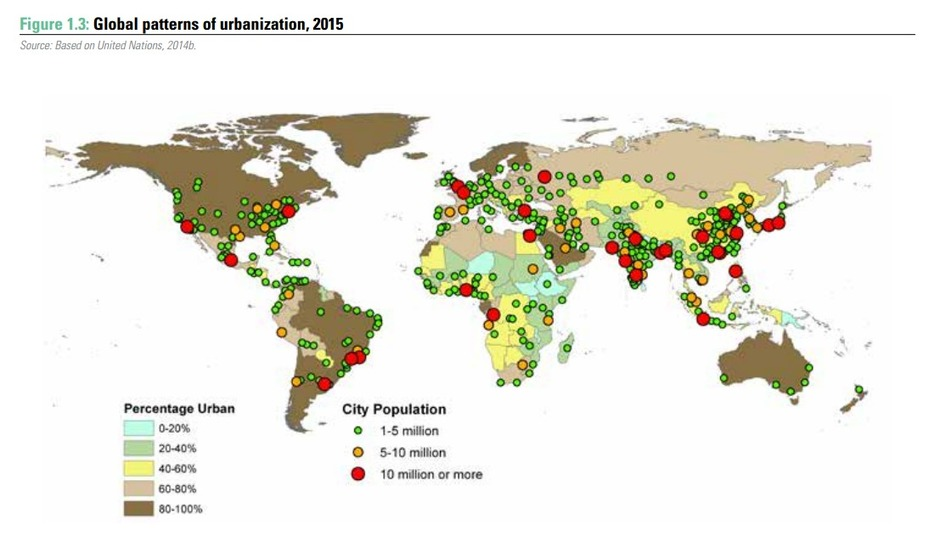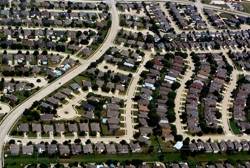AP HUMAN GEOGRAPHY UNIT 6
1/47
Earn XP
Description and Tags
Name | Mastery | Learn | Test | Matching | Spaced |
|---|
No study sessions yet.
48 Terms
site
the exact physical location of a settlement or place, including its inherent characteristics like topography, climate, vegetation, and availability of water
situation
the location of a place in relation to its surrounding features
urbanization
the process where a large population shifts from rural areas to urban areas, resulting in the growth of cities and a higher concentration of people living in towns and cities
meGacities
a very large urban area with a population exceeding 10 million people

meTacities
an urban area with a population exceeding 20 million people
core
a region or country that is highly developed economically, dominating global trade, with advanced technology, high levels of wealth, and significant political influence
periphery
a region that is less economically developed, often relying on raw material extraction and agriculture, with limited access to technology and investment, typically situated on the outer edges of a global economic system compared to more developed "core" regions
semi periphery
a country or region that sits between the core (most developed) and periphery (least developed) areas in the global economy, exhibiting characteristics of both, often acting as a middle ground where manufacturing and exporting occur, with a standard of living higher than peripheral countries but lower than core countries;
metropolitan area
a region encompassing a densely populated urban core city and its surrounding communities, characterized by significant economic, social, and cultural interactions between residents
megalopolis
a large, interconnected urban region formed by the merging of several metropolitan areas
urban sprawl
the uncontrolled expansion of urban areas into surrounding rural land, characterized by low-density residential development, increased reliance on automobiles, and often a lack of comprehensive urban planning, resulting in the consumption of large amounts of land and potential environmental impacts.
boomburbs
a large, rapidly growing suburban city that maintains its suburban character even as it reaches a population size more typical of a major urban core

Exurbs
a residential area located beyond the traditional suburban zone, situated at the edge of a metropolitan area, with a connection to the city's economy through commuting, but maintaining a lower density and more rural character compared to the suburbs
Edge cities
a decentralized urban area that develops on the outskirts of a traditional city center, characterized by a concentration of business, shopping, and entertainment facilities, often emerging due to suburbanization and providing residents with a self-contained hub for work and leisure without needing to commute into the central city
world city
a major urban center that serves as a hub for global economic, cultural, and political activities
rank size rule
a pattern where a city's population size is inversely proportional to its rank within a country
a country’s nth-largest settlement is 1/n the population of the largest settlement.
primate city rule
the largest city in a country, significantly larger than any other city in the nation, exerting disproportionate economic, political, and cultural influence, often with a population at least twice the size of the second largest city
gravity model
a mathematical formula that predicts the interaction between two places based on their population size and the distance between them
christaller’s central place theory
geographical model that explains the pattern of settlements based on the idea that people will travel the shortest distance possible to access goods and services, leading to a hierarchy of settlements where larger cities with more specialized services are surrounded by smaller towns and villages providing basic needs, with the larger settlements spaced further apart to minimize competition and maximize market reach
threshold
a large shopping mall needing a substantial population nearby to generate enough customers to stay open
range
the maximum distance people are willing to travel to access a particular good or service
bid-rent theory
a geographical economic concept explaining how the price and demand for land decreases as the distance from a city's central business district (CBD) increases
burgess concentric model
a theory that describes a city as a series of concentric rings expanding outward from the central business district (CBD), with each ring representing different socio-economic groups and land uses
hoyt sector model
suggests that people will live in the different sectors based on income levels
Harris and Ullman Multiple Nuclei Model
a theory that cities develop not around a single central business district, but rather around multiple centers or "nuclei," each with its own distinct function
galactic city model
a conceptual model depicting a decentralized urban landscape where multiple suburban "edge cities" are connected by major transportation arteries like beltways, with less emphasis on a traditional central business district (CBD), signifying a city heavily influenced by car-dependent development and suburban sprawl
Latin American model
a spatial model is characterized by a central business district (CBD), a prominent elite residential sector along a commercial spine, and a series of concentric zones with declining residential quality further from the CBD, often including a peripheral zone of squatter settlements, reflecting the impacts of colonization and uneven development across the city
Southeast Asian model
a theoretical model characterized by a central business district heavily focused around a port area, with surrounding residential zones that often segregate by income level, with lower-income areas located on the periphery and higher-income areas closer to the center, often influenced by colonial legacies and trade patterns
Sub-saharan African cities model
a theoretical model typically characterized by multiple central business districts (CBDs) including a traditional market area, a European colonial center, and a modern developing CBD, often with distinct ethnic neighborhoods and informal settlements on the periphery
market area (central place theory)
a geographic zone where a settlement or service provider draws its customers from
hinterland
The area surrounding a central place (like a city or port) that is economically and culturally influenced by that place
Infilling
the redevelopment of vacant or underutilized land within existing urban areas
qualitative data
non-numerical information that describes qualities, characteristics, and experiences, often gathered through interviews, observations, or open-ended surveys, providing insights into human behavior and cultural contexts
quantitative data
numerical information that can be counted, measured, and analyzed statistically, providing objective insights into geographic phenomena and patterns.
census tract
a small, relatively permanent statistical subdivision of a county used for collecting and analyzing demographic data, typically containing between 1,200 and 8,000 residents.
sprawl
the unplanned, often low-density, expansion of urban and suburban areas over a large area, characterized by a scattering of development and a decline in population density.
brownfields
abandoned, idled, or underused industrial or commercial properties where expansion or redevelopment is complicated by real or perceived environmental contamination.
greenbelts
a designated area of open, undeveloped land surrounding urban areas, intended to limit urban sprawl, protect natural habitats, and promote sustainable land use by preserving green spaces for recreation, agriculture, and wildlife conservation
new urbanism
a planning and development approach that promotes walkable, mixed-use communities with a focus on human-scale design, sustainable living, and counteracting suburban sprawl
De facto segregation
the separation of groups, often racial or ethnic, that occurs not as a result of laws or policies, but due to factors like housing patterns, social customs, or economic disparities
slow growth cities
a city that actively implements policies and practices to limit the pace and scale of new development, often aiming to reduce outward expansion and prevent urban sprawl
redlining
a discriminatory practice where financial institutions (like banks and insurers) deny or limit loans, mortgages, insurance, or other services to individuals based on the racial or ethnic composition of the area where they live
blockbusting
a real estate practice where agents induce panic selling by white homeowners in neighborhoods undergoing racial integration, exploiting fears of declining property values and neighborhood change
ghettos
a spatially confined area where a particular racial, ethnic, or social group is concentrated, often due to historical patterns of segregation, discrimination, and economic disadvantage, leading to social isolation and limited opportunities.
squatter settlements
an area within a city, typically in a less developed country, where people illegally establish residences on land they do not own or rent, erecting homemade structures
slums
a densely populated, urban area characterized by inadequate housing, poor infrastructure, and often, squalid living conditions, primarily inhabited by impoverished people
zones of disamenity
urban areas characterized by poverty, social instability, and inadequate access to essential services, often marked by poor infrastructure and high crime rates
gentrification
a complex urban process where a previously low-income neighborhood undergoes revitalization through investment, leading to increased property values and the displacement of long-term, lower-income residents by wealthier newcomers